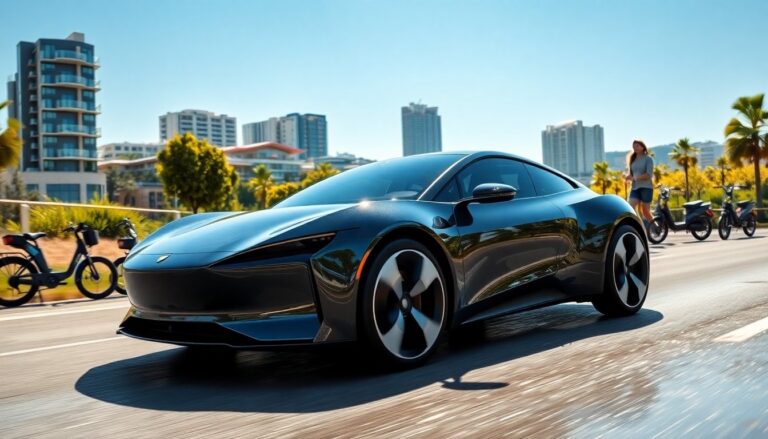Argomenti trattati
The automotive industry is undergoing a significant transformation, fueled by technological advancements and shifting consumer preferences. As we navigate the complexities of the 21st century, the integration of digital technology into vehicles represents not just a trend, but a fundamental change in how we approach driving. This article explores the latest innovations within the automotive sector and how they are reshaping the concept of mobility.
Electric vehicles: a sustainable future
Among the most notable trends in the automotive landscape is the surge of electric vehicles (EVs). As concerns about climate change and environmental sustainability intensify, manufacturers are increasingly directing resources toward the development of EVs. Leading automotive companies, including Tesla, Ford, and General Motors, are swiftly expanding their electric vehicle portfolios to meet the demands of a more environmentally aware consumer base.
Benefits of electric vehicles
Electric vehicles provide a range of advantages compared to traditional gasoline-powered cars. They generate zero tailpipe emissions, which significantly reduces their environmental footprint. Furthermore, EVs typically incur lower operating costs due to decreased fuel and maintenance expenses. With ongoing advancements in battery technology, the range and performance of electric vehicles are continually improving, enhancing their practicality for daily use.
Role of government policies
Government incentives are crucial in promoting the adoption of electric vehicles. Numerous countries are implementing subsidies and tax breaks to motivate consumers to transition to EVs. For example, the United States has introduced tax credits for EV purchases, while several European nations are setting ambitious goals for phasing out internal combustion engines. These policies are vital for cultivating a sustainable automotive future.
Autonomous vehicles: shaping the future of driving
The rise of autonomous vehicles marks a significant shift in transportation. Industry leaders such as Waymo, Uber, and Tesla are pioneering this technology, which has the potential to transform how we travel. By removing the need for human drivers, self-driving technology aims to minimize traffic accidents, improve traffic flow, and bolster road safety.
Understanding autonomous vehicle technology
At its core, an autonomous vehicle utilizes a combination of sensors, cameras, and artificial intelligence to navigate roads and make real-time decisions. These vehicles depend on intricate algorithms to interpret data from their environment, ensuring safe and efficient travel. As this technology evolves, we anticipate an increase in vehicles equipped with advanced driver-assistance systems (ADAS). These systems enhance safety features, including lane-keeping assistance and adaptive cruise control, setting the stage for a new era in automotive innovation.
Challenges in autonomous vehicle adoption
The journey toward widespread adoption of autonomous vehicles faces several obstacles. Regulatory hurdles create a complex landscape for manufacturers and regulators alike. Public skepticism about the safety and reliability of self-driving technology adds another layer of difficulty. Moreover, technological limitations still hinder the full realization of autonomous driving capabilities.
In addition to these challenges, concerns regarding cybersecurity are paramount. As vehicles become increasingly connected, the risk of hacking and data breaches grows. There are also significant ethical implications to consider, such as decision-making in critical situations. Addressing these issues is essential before autonomous vehicles can truly become a common sight on our roads.
Connectivity and smart technology in vehicles
The integration of connectivity and smart technology in vehicles is revolutionizing the driving experience. Today’s vehicles feature sophisticated infotainment systems that offer drivers seamless access to navigation, entertainment, and communication. The emergence of the Internet of Things (IoT) further enhances this landscape, allowing cars to communicate not only with each other but also with surrounding infrastructure. This advancement is laying the groundwork for a more intelligent and efficient transportation ecosystem.
The impact of connected vehicles
Connected vehicles are transforming the driving landscape by sharing real-time data with one another. This innovation significantly enhances safety and reduces traffic congestion. For instance, when one vehicle detects a hazard on the road, it can instantly alert nearby cars. This vital exchange of information can help avert accidents and improve the overall driving experience. Additionally, automakers are increasingly prioritizing over-the-air updates to maintain vehicle software, ensuring that drivers benefit from the latest features and security improvements.
Consumer preferences and expectations
As connectivity becomes integral to modern vehicles, consumer expectations are rapidly changing. Today’s drivers seek vehicles that offer more than just transportation; they demand seamless integration with their digital lifestyles. This evolving landscape compels manufacturers to innovate continuously, striving to keep their vehicles competitive in a dynamic market.
The automotive industry is poised for a significant transformation driven by electric vehicles, autonomous driving, and improved connectivity. These innovations are set to reshape our understanding of mobility, ushering in a more sustainable and safer future. As these changes unfold, it is essential for both manufacturers and consumers to adapt and embrace this exciting evolution in automotive technology.

